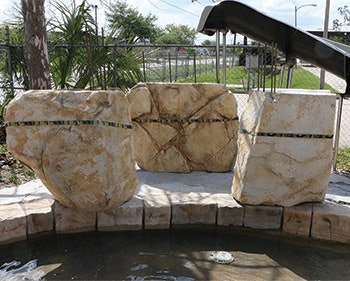 If cast-rock boulders were made out of natural stone, they would be extremely heavy, causing stress on the edge of a pool and encouraging the pool to settle.
If cast-rock boulders were made out of natural stone, they would be extremely heavy, causing stress on the edge of a pool and encouraging the pool to settle.
While current or prospective pool owners may be unaware of what a cave, grotto, waterfall or slide can do for their pool, builders may want to consider offering these features as options because they add profit to the sale and make pools more aesthetically pleasing and fun. Today's component grotto and cave kits allow builders to provide an exciting custom pool package at a price that fits a wide range of budgets.
Caves and grottos are basically "super" waterfall features. They provide all the benefits of a waterfall (visual beauty and the calming sound of cascading water) but also add a large measure of fun and excitement to the feature, especially for children. With a generated mist settling over a cave, making everyday figures indistinct and mysterious, a young person's imagination can fill in the details of a wild pirate adventure.

Unlike previous options of artificial rock cast from rubber molds, the beauty of these new component systems is that they really look like real rock because they are cast from real rock — with the same shape, character and texture of real rock. It's virtually impossible to tell the difference between real rock and the new cast-rock. These new component systems are, in effect, a type of 'kit' that allows builders to show consumers a brochure of what the final product will look like at the time they sell the job. Once ordered, builders receive kits that come complete with all parts for assembly.
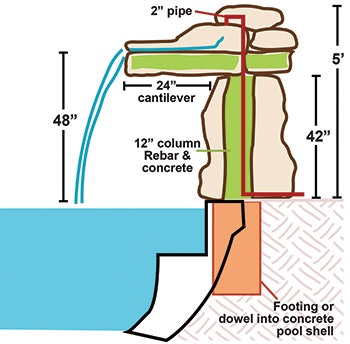 Schematic of a cave waterfall showing plumbing return. It is recommended that the base pieces overhang the pool beam by 1-2 inches to minimize any chance of seepage under the waterfall.
Schematic of a cave waterfall showing plumbing return. It is recommended that the base pieces overhang the pool beam by 1-2 inches to minimize any chance of seepage under the waterfall.
For those thinking about offering grotto and cave water features, here are some considerations:
Selling: When selling grotto and cave water features, budget is always a central consideration, as it is in any construction project. Showing a "good, better, best and super best" option to consumers allows them to pick within their budget. Many water features include grottos and caves and price out in the $5,000 to $10,000 range while larger rotomolded slides and larger waterfalls tend to be more in the $10,000 to $15,000 range. Fiberglass flume slides with rock type staircases and waterfall options can go from $15,000 to $50,000.
Landscaping: Landscaping is the key to making these water features blend naturally into the backyard. When we first started offering them, we found that consumers were going to professional landscapers for both the water feature and the surrounding grounds. But unfortunately, landscapers can often unintentionally create a water feature that compromises the pool in some way. Having a water expert who offers landscaping allows the backyard retreat to be integrated under one company.
Functionality: Not only is it important that the finished look of the cave or grotto is appealing and well-integrated, but it's also critical to be sure the water flowing over the water features actually gets back into the pool. If there's a leak somewhere in the circuit, the water can get underneath the pool and cause some real issues. Before these component grotto/cave/waterfall systems, it was very hard to ensure the water would flow back into the pool after flowing over a mass of natural boulders.
Weight: Grottos and caves are very attractive but if they were made out of natural stone, they would be extremely heavy. Putting a large amount of weight on the edge of a pool can compress the ground and settle the entire pool. Modern component grotto/cave systems on the other hand are about 1/5th the weight of natural stone and designed with a weight distribution per foot that takes pool construction into consideration.
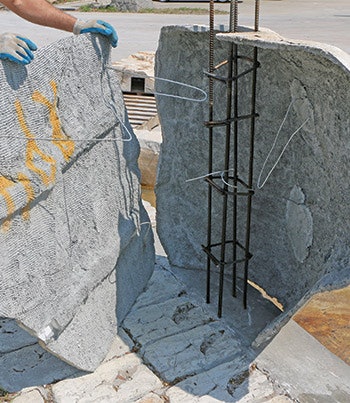 A rebar column is part of the kit. 5-foot wall sections are wired to the rebar frame that becomes the back of the cave. Columns should be strapped and braced before filling.
A rebar column is part of the kit. 5-foot wall sections are wired to the rebar frame that becomes the back of the cave. Columns should be strapped and braced before filling.
Time: All pool builders and renovators know the importance of being able to know exactly how much time it will take to execute any particular part of a job. Not only to price the job appropriately, but also for planning and scheduling. Building water features with natural stone can be really unpredictable. You might spend all day arranging the natural boulders, but then the customer comes home and says they think they would like to see the stones arranged in another way. Working with natural stone can often be a tricky enterprise and labor costs can get out of control very quickly.
Component water feature systems remove a lot of the risk and typically take a half-day to a full day for a crew of four people, while a large, complicated job with slides and multiple add-ons might take closer to three weeks.
Training: Builders agree that training is key to successfully building cave and grotto water features. It's important to partner with a supplier that offers hands-on training. Whether that is training on the first job or hands-on-training at a facility or pool, there are some tips and tricks that can make a builder's job easier and more cost-effective. New installers can often count on the manufacturer to supply technical support, in the field, for first time installations.
Adding slides, staircases and other fun options: Kids want to play under, jump off or slide down these water features, and that requires the building of a staircase or often adding a slide. A modular staircase system can easily be built in one day — much faster than the three-to-four days it would take to build a staircase system from scratch. The labor savings alone makes the component system extremely price competitive in the marketplace. Today's builders can offer a grotto with a staircase for $2,000 to $3,000; perhaps $6,000 to $8,000 for an elaborate custom design.
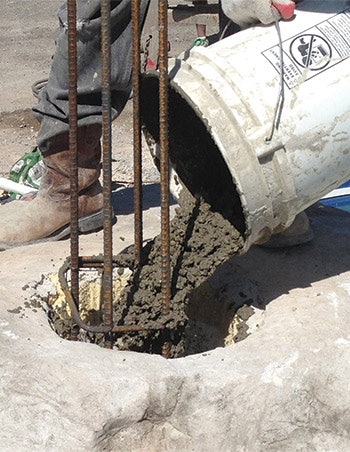 Fill columns with 3,000-psi concrete mix. Foam can be used as a filler around the columns.
Fill columns with 3,000-psi concrete mix. Foam can be used as a filler around the columns.
The Construction Process
The following a brief overview of the construction of component grotto and cave water features. It's important to understand that component grotto water feature systems have a steel structure and require a bond wire to meet most building codes. The concrete pad should have a bond break at the pool shell and should slope toward the pool. It is recommended that you have four inches of concrete on the pad.
Placement: It is recommended that the base pieces hang over the pool beam by 1 to 2 inches to minimize any chance of seepage under the waterfall. The base pieces and ledgers generally have a drip line, but water might still run down the face of a rock. The most popular grotto cave size is 10-feet long and 42-inches tall from the deck with about a 4-foot-wide 'cave area' for sitting that is about 21-inches tall above the pool waterline.
Handholds: If the grotto or cave is placed in an area of the pool with over 4 feet of water, building codes generally require that a "handhold" be created. This can be done easily by setting the waterfall back from the beam about 2 to 3 inches, but the beam must slope toward the pool to prevent seepage. Nine-inch coping is often used to create a handhold and extend the rock into the pool.
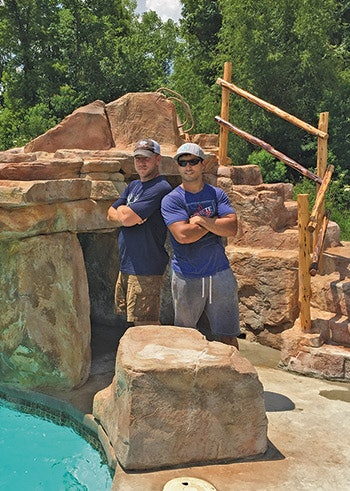 A finished cave and waterfall, enhancing the value and appeal of an ordinary backyard pool, provides a feeling of satisfaction to builder and homeowner alike.
A finished cave and waterfall, enhancing the value and appeal of an ordinary backyard pool, provides a feeling of satisfaction to builder and homeowner alike.
Mortar Techniques: Today's component system castings can be very dense; since they do not absorb water, they must be set with a rich mortar mix. Most masonry supply businesses and home improvement stores have a better quality mortar mix or a mortar cement that can be mixed with masonry sand that will work well. Mortar should be easy to trowel into place, not too runny or too stiff. Mortar beds should be about 1 inch or more for base pieces and less for smaller rocks. It's important to scrub mortar to the underside of the rock for maximum bonding.
Conclusion
Technological advances have made possible attractive component systems molded from real rock — with the shape, character and texture of real rock — providing an easy-to-build kit that can be integrated into a builder's repertoire. These systems offer builders new possibilities in terms of package add-ons, which enhance a project and its profit.
Bruce Riley is managing director of Rico Rock, a manufacturer of pool rock and water features with corporate offices in Orlando, Fla.
Comments or thoughts on this article? Please e-mail [email protected].











































